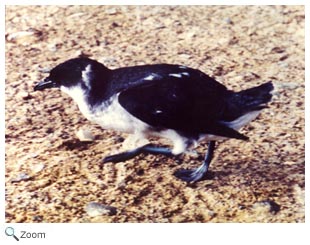Pelecanoididae -
Diving Petrels |
|
|
 There are four species of small seabirds in this family. They are found on oceans in the Southern Hemisphere. There are four species of small seabirds in this family. They are found on oceans in the Southern Hemisphere.
Diving petrels are dark brown or black with white markings. They have stocky bodies; short, thick necks; short wings; and tubular nostrils.
Diving petrels stay closer to land than other members of the procellariiformes order. Diving petrels come onto land to nest. They arrive on their nesting sites at night and nest in colonies. Females lay a single egg in a burrow in the ground. Both the male and female incubate the egg.
World Status Key
 Least Concern Least Concern  Near Threatened Near Threatened  Vulnerable Vulnerable  Endangered Endangered  Critically Endangered Critically Endangered  Extinct in Wild Extinct in Wild  Extinct Extinct
Status and range is taken from ICUN Redlist. If no status is listed, there is not enough data to establish status.
US Status Key
 Threatened in US Threatened in US  Threatened in NH Threatened in NH  Endangered in US Endangered in US  Endangered in NH Endangered in NH  Breeds N.H. Breeds N.H.  Introduced Introduced
Status taken from US Fish and Wildlife and NH Fish and Game
New Hampshire Species |
|
North/Central American Species |
None
|
|
None |
Additional Information
Key:  Profile Profile  Photos Photos  Video Video  Audio Audio
Common Diving-petrel - Pelecanoides urinatrix       
The common diving-petrel is found off the coasts of Argentina, Australia, Chile, Falkland Islands, the French Southern Territories, Heard Island and McDonald Islands, New Zealand, Saint Helena, South Africa, South Georgia and the South Sandwich Islands, and Uruguay.
Source: Animal Diversity Web Intended Audience: General Reading Level: Middle School Teacher Section: Yes
Common Diving-petrel - Pelecanoides urinatrix      
The common diving-petrel can dive to depths of 200 feet.
Source: Internet Bird Collection Intended Audience: General Reading Level: Middle School Teacher Section: No
Magellanic Diving-petrel - Pelecanoides magellani    
The Magellanic diving-petrel is found off the coasts of Argentina, Chile, and the Falkland Islands.
Source: Animal Diversity Web Intended Audience: General Reading Level: Middle School Teacher Section: Yes
Magellanic Diving-petrel - Pelecanoides magellani    
The Magellanic diving-petrel is black on its upperside and white on breast, belly, and rump.
Source: Internet Bird Collection Intended Audience: General Reading Level: Middle School Teacher Section: No
Peruvian Diving-petrel - Pelecanoides garnotii     
The Peruvian diving-petrel is found off the coasts of Peru and Chile.
Source: Arkive Intended Audience: General Reading Level: Middle School Teacher Section: Yes
Peruvian Diving-petrel - Pelecanoides garnotii    
The Peruvian diving-petrel is black on its upperside and white on breast, belly, and rump.
Source: Internet Bird Collection Intended Audience: General Reading Level: Middle School Teacher Section: No
Peruvian Diving-petrel - Pelecanoides garnotii    
The Peruvian diving-petrel breeds on only four islands.
Source: BirdLife International Intended Audience: General Reading Level: High School Teacher Section: No South Georgia Diving-petrel - Pelecanoides georgicus      
The South Georgia diving-petrel breeds on oceanic volcanic islands in the sub-Antarctic.
Source: Arkive Intended Audience: General Reading Level: Middle School Teacher Section: Yes
South Georgia Diving-petrel - Pelecanoides georgicus      
The South Georgia diving-petrel has blue legs and feet.
Source: Internet Bird Collection Intended Audience: General Reading Level: Middle School Teacher Section: No
|
 There are four species of small seabirds in this family. They are found on oceans in the Southern Hemisphere.
There are four species of small seabirds in this family. They are found on oceans in the Southern Hemisphere.
